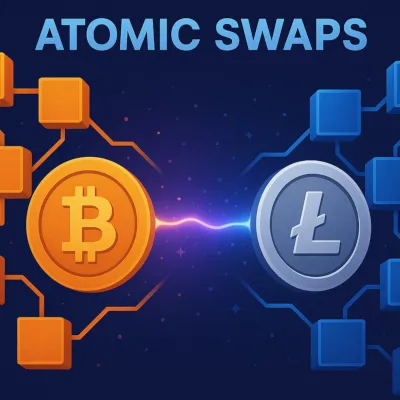What are Atomic Swaps and how do they work?

Since the creation of Bitcoin in 2008, the cryptocurrency landscape has expanded to include thousands of different digital assets. This diversification has increased the need for traders to exchange one cryptocurrency for another. To meet this demand, atomic swaps were developed, enabling users to trade two different cryptocurrencies directly from their wallets without relying on a third-party intermediary like a centralized exchange.
This technology facilitates a direct, secure, peer-to-peer exchange across different blockchains, representing a significant step toward a more decentralized financial system.
What Are Atomic Swaps?
Atomic swaps, also known as cross-chain atomic swaps, enable the peer-to-peer exchange of cryptocurrencies operating on different blockchains without a centralized intermediary. This process provides a trustless and non-custodial exchange, involving only the two trading parties.
The term "atomic" is derived from atomicity, a computing principle ensuring that a transaction is an indivisible, single operation. In the context of a swap, this means the exchange either completes in its entirety or fails completely, with no partial transfer of funds. This prevents a scenario where one party sends funds but does not receive anything in return.
The concept was first discussed by Sergio Damien Lerner in 2012, who envisioned a way to trade coins directly against Bitcoin. Tier Nolan later coined the term "atomic swap" in 2013 while detailing the underlying technology. The first practical application occurred in 2017 when Litecoin founder Charlie Lee successfully performed a cross-chain swap between Litecoin (LTC) and Bitcoin (BTC), exchanging 10 LTC for 0.1137 BTC. Following this milestone, atomic swaps have been integrated into various decentralized exchanges, wallets, and platforms.
How Do Atomic Swaps Work?
Underlying Technology
Atomic swaps are powered by Hashed Timelock Contracts (HTLCs). An HTLC is a type of smart contract that requires parties to meet specific cryptographic conditions within a set timeframe to execute a transaction. It consists of two key components. A hashlock secures the deposited cryptocurrency until both parties provide cryptographic proof that they have fulfilled their side of the agreement. A timelock establishes a deadline for the transaction. If the swap is not completed within this period, the transaction is automatically canceled, and the funds are returned to their original owners. Together, these features protect against counterparty risk and ensure the security of the funds involved.
A Step-by-Step Example
Imagine Alice wants to swap her 0.1 Bitcoin (BTC) for Bob's equivalent amount of Litecoin (LTC).
- Alice initiates the swap by creating an HTLC and depositing her 0.1 BTC into a contract address. This action also generates a secret number, known as a preimage, and she sends its cryptographic hash to Bob.
- Bob verifies that Alice's BTC is locked in the contract using the hash. He cannot access the funds, but he can confirm they are there.
- Bob then creates his own HTLC on the Litecoin blockchain, depositing the agreed-upon amount of LTC and locking it with the same hash provided by Alice.
- Alice uses her secret preimage to claim the LTC from Bob's contract. Since she is the only one who knows the preimage, only she can unlock the funds.
- When Alice claims the LTC, the preimage is revealed on the Litecoin blockchain.
- Bob now sees the revealed preimage and uses it to unlock and claim the 0.1 BTC from Alice's contract on the Bitcoin blockchain.
- The swap is complete. If either party fails to act within the specified timeframe, the timelock expires, and the smart contracts automatically refund the coins to their original owners.
On-Chain vs. Off-Chain Atomic Swaps
On-chain atomic swaps are executed directly on the respective blockchains using HTLCs. These transactions are publicly recorded and require that the two blockchains share compatible scripting features and hashing algorithms. However, on-chain swaps can be slow and expensive due to network congestion and the waiting times required by the HTLCs.
Off-chain atomic swaps are executed on second-layer solutions built on top of a blockchain, rather than directly on the main chain. These solutions, such as the Lightning Network, leverage channels to enable faster transactions and lower fees. While still relying on the principles of HTLCs, moving the process off-chain significantly improves efficiency and scalability.
Benefits of Atomic Swaps
Decentralization
Atomic swaps eliminate the need for centralized authorities, allowing users to transact directly with one another. This gives traders complete control over their private keys and assets throughout the process.
Security
As a non-custodial exchange method, atomic swaps are not vulnerable to the hacks or theft that can affect centralized exchanges holding user funds. The HTLC mechanism ensures funds are safe, as the swap only executes if all conditions are met.
Privacy
Unlike centralized exchanges that require Know-Your-Customer (KYC) verification, atomic swaps preserve user privacy by not requiring personal information to be shared before a transaction can occur.
Cost-Effectiveness
By removing intermediaries, atomic swaps reduce transaction costs. Users only pay the standard network fees on the respective blockchains, avoiding the additional trading fees charged by exchanges.
Interoperability
Atomic swaps promote cross-chain interoperability by allowing assets to move seamlessly between different blockchains without relying on a third party, breaking down the barriers that isolate blockchain ecosystems.
Challenges and Limitations
Limited Blockchain Support
Atomic swaps can only be performed between blockchains that use the same hashing algorithm (e.g., SHA-256 for Bitcoin and Litecoin). This requirement limits their use across the broader crypto ecosystem.
User Experience
Executing an atomic swap often requires a degree of technical understanding that may be daunting for beginners. The process is more complex than trading on a user-friendly centralized exchange.
Speed and Scalability
On-chain atomic swaps can be slow, with transaction times dependent on block confirmation times. This makes them unsuitable for high-frequency trading or situations requiring immediate execution.
Smart Contract Risks
Like any smart contract-based technology, HTLCs can have vulnerabilities. An improperly coded or deployed contract could be exploited by malicious actors, leading to a loss of funds.
Privacy Concerns
While atomic swaps do not require KYC, on-chain transactions are public. The details of the swap, including wallet addresses and amounts, are visible on the blockchain, which can be a privacy concern for some users.
Use Cases and Real-World Adoption
Decentralized Exchanges (DEXs) and Wallets
One of the most common applications of atomic swaps is within decentralized exchanges and non-custodial wallets. While many DEXs only support tokens on a single blockchain, those integrating atomic swaps can offer cross-chain trading. AtomicDEX by Komodo is a platform that functions as both a multi-coin wallet and a DEX supporting swaps for assets like Bitcoin and Ethereum. Similarly, wallets like Liquality leverage atomic swaps to provide seamless cross-chain exchanges directly within the user interface.
Layer-2 Protocols
Layer-2 solutions are ideal platforms for executing atomic swaps due to their speed and low cost. The Lightning Network, a Layer-2 protocol built on Bitcoin, uses HTLCs as its core payment mechanism. This shared technology allows the Lightning Network to facilitate fast, off-chain atomic swaps between compatible cryptocurrencies, addressing the scalability issues of on-chain swaps.
The Future of Atomic Swaps
Cross-chain interoperability is a rapidly growing area of interest in the cryptocurrency space. As more decentralized protocols adopt tools that support transactions across different blockchains, atomic swaps are becoming increasingly relevant. They play a crucial role in enhancing liquidity in Decentralized Finance (DeFi) by enabling assets to flow freely between ecosystems.
By removing barriers, atomic swaps foster wider adoption of cryptocurrencies and DeFi, giving traders easy access to deep liquidity and applications while they retain full custody of their assets. While scalability remains a challenge, the development of Layer-2 protocols with atomic swap capabilities, like the Lightning Network, points toward a more efficient future. The evolution of these Layer-2 solutions will likely be key to enabling scalable cross-chain transactions on a broader scale.
Conclusion
With a vast number of cryptocurrencies in existence, the need for a secure, peer-to-peer method for cross-chain exchange is clear. Despite their current limitations, atomic swaps preserve the core crypto principles of security, privacy, and decentralization. They improve access to liquidity within DeFi and play a significant role in building a trustless financial future where users can interact with a wide range of tools while retaining full control of their assets.
This article is for informational purposes only and should not be considered financial advice. Always conduct your own research and consult with a qualified professional before making investment decisions.

 Roman Klochko
Roman Klochko